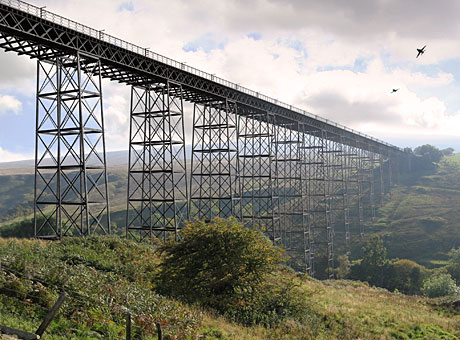|
However much we appreciate it, fresh air rarely fires the imagination. So you might think that visiting 1,040 feet of it has all the hallmarks of a paint-drying experience. Far from it. As I heaved my Michelin remoulded midriff up a Cumbrian hillside, fresh air revealed a new, inspiring dimension.
Facing each other across a deep ravine were two stone abutments, separated by the industrial vandalism of the 1960s. The empty space between them was formerly occupied by Belah Viaduct and, if you closed your eyes, the wind could still be heard whistling through its girders.
 |
| A virtual reconstruction of how Belah Viaduct might look today. |
Belah was an engineering giant. Sixteen iron trestles lifted the Stainmore line into the sky, 196 feet above the river which gave the structure its name. No other English bridge had ever reached so high. Back in 1861, the cost of this colossus was just £31,630. Thanks to the number crunching of a tame economics professor, that’s the equivalent of around £1.97 million in 2006 - chickenfeed by today’s standards.
The renewal of Brougham Street bridge in Burnley - as bog-standard a construction as you could hope to find - recently hoovered £2million from down the back of the sofa. At less than 500 yards, the Allington chord would have been a gentle stroll for the Victorians but attracted a budget of £12million. Infrastructure isn’t cheap anymore.
 |
| Brougham Street bridge in Burnley. |
The reasons for this are many and varied. Not unreasonably, we aspire to far higher standards of living than our 19th Century predecessors. Innovation and technology come at a price. Unwieldy processes have joined hands with weak project management to push costs through the roof and they’ve been propelled skywards by our inflexible, non-risk-based approach to safety. The glut of superficial adornments act as solid rocket boosters.
We all have a right to be healthy and safe, but these basic expectations have acquired a bad name thanks to ‘health and safety’ - a national joke which has grafted itself onto the railway like a leach. Whilst some frontline problems are overlooked, legions of functionaries happily churn out 238-page Safety Performance Reports, offer ergonomics seminars at £717 per head and build ‘decision-taking frameworks’. Who, in a position of any influence, has the time or inclination to engage with this stuff?
Don’t get me wrong - I know many safety managers and some high-level strategists who’ve made a positive difference to the everyday lives of our workforce. More power to their elbow. But an overloaded gravy train has failed on the slow line, obstructing the way forward and discharging a thick, sticky fog into the ether. Too much health and safety output is just upholstery, cushioning companies - often unsuccessfully - against liability. An illusion of activity is created which offers little discernible value where it matters most.
|
| An overloaded gravy train has failed on the slow line, obstructing the way forward and discharging a thick, sticky fog into the ether. |
|
When contractors Gilkes, Wilson & Co were charged with erecting Belah Viaduct, would they have been any the wiser for research project T306 - ‘Managing uncertainty in the safety risk model’? Could they have benefited from a Decision Support Manager’s input? Might the Rail Sustainability Masterclass have influenced their approach? No? Really?
Here’s a challenge for you. For each work task you complete today, consider what operational difference it makes to the railway. Think long term as well as short. Will trackworkers be safer? Is train performance likely to improve? Could costs be driven down? Be honest with yourself.
Though demoralising for some, this kind of analysis - and action based upon it - is vital if the industry is to shatter its wasteful, sloth-like reputation. It soaks up more than one-third of the country’s transport budget yet only 6% of passenger journeys are taken by train.
If new infrastructure is made more affordable, the railway is well placed to offer an escape route from Gridlock Britain. The rampant obesity of our safety structure has a debilitating impact on the industry’s general health and is in need of radical treatment, preferably with a machete. Let’s applaud Network Rail for sharpening its blade and encourage a wider debate on safety management, driven by frontline risk rather than cosmetic appearance. It’s no longer tenable to invest in irrelevance simply because there’s a budget to be spent or box to be ticked.
Story added 1st September 2006
|